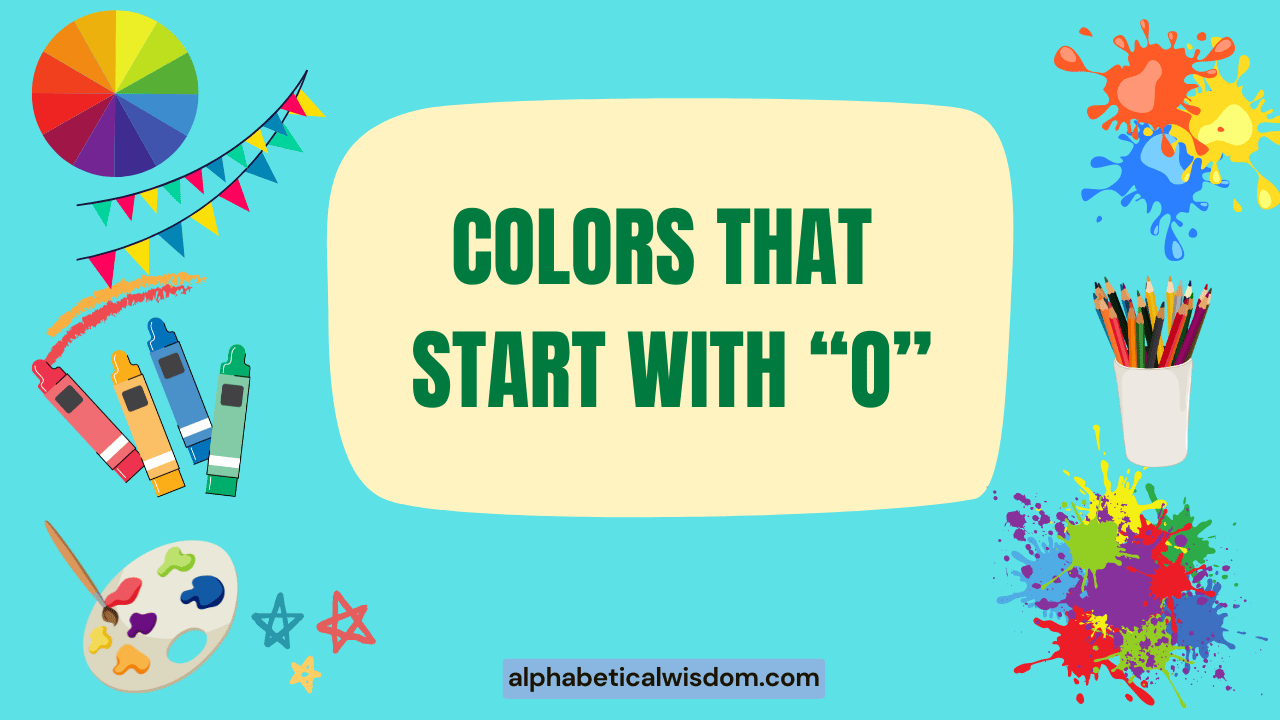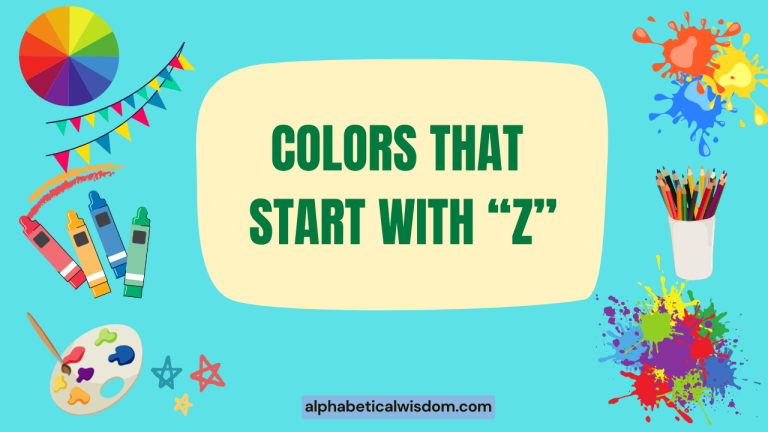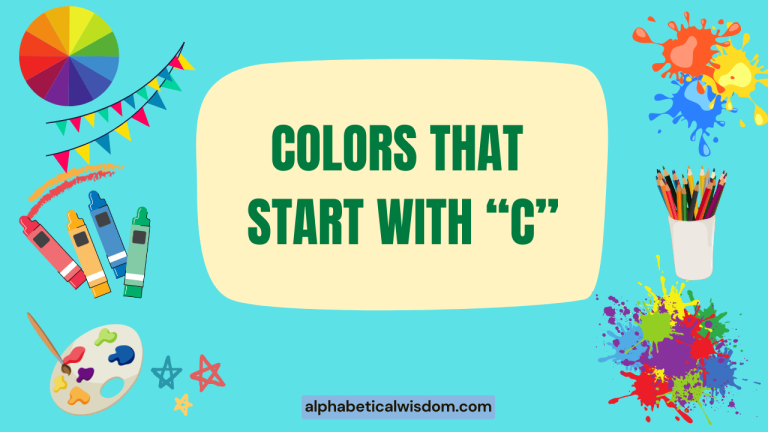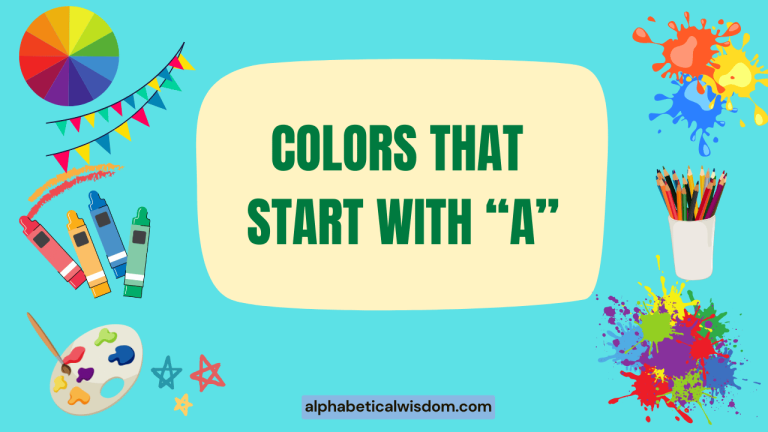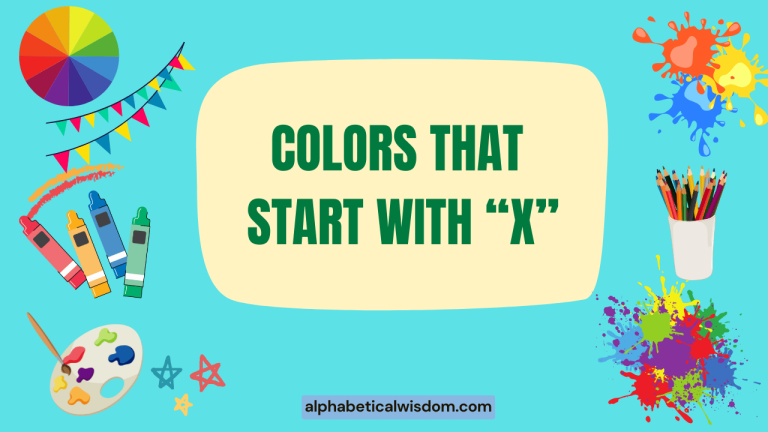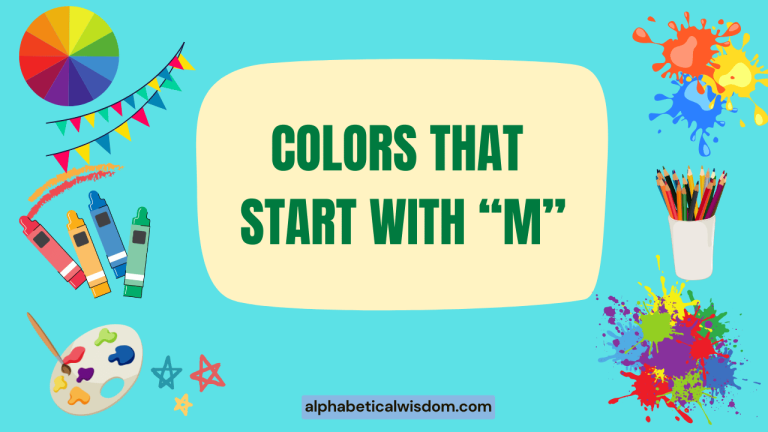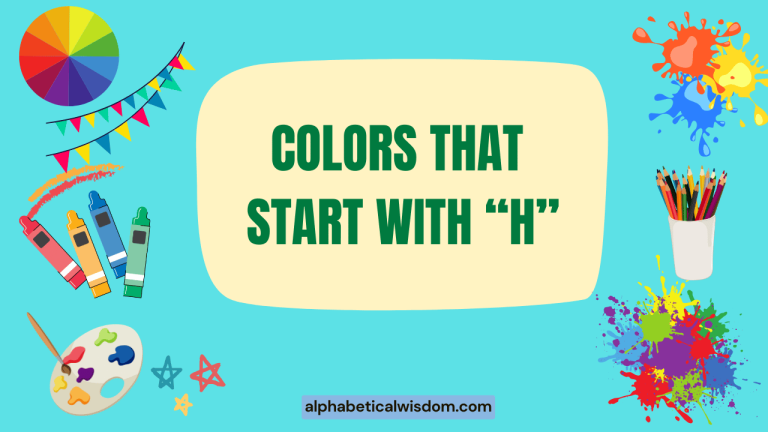Colors That Start With O: A Comprehensive Guide
Understanding colors is fundamental in English, influencing how we describe the world around us. While the English language boasts a vast spectrum of color names, some are less commonly used than others.
This article focuses specifically on colors that start with the letter “O,” exploring their nuances, usage, and significance. This guide is perfect for English language learners, writers, artists, and anyone looking to expand their color vocabulary and improve their descriptive skills.
Table of Contents
- Introduction
- Definition of Colors Starting with “O”
- Structural Breakdown of Color Names
- Types and Categories of Colors Starting with “O”
- Examples of Colors Starting with “O” in Sentences
- Usage Rules for Colors in English
- Common Mistakes When Using Color Names
- Practice Exercises
- Advanced Topics: Color Theory and Language
- Frequently Asked Questions
- Conclusion
Definition of Colors Starting with “O”
Colors are visual perceptions that arise from the stimulation of photoreceptor cells in the eyes by electromagnetic radiation (light) within the visible spectrum. In the English language, color names function primarily as adjectives, modifying nouns to describe their hue.
Colors that start with “O,” like ochre, olive, and orange, are used to specify particular shades and tones within the broader color spectrum. These color names can also function as nouns, referring to the color itself as a concept or entity.
The classification of colors can be based on various systems, including the RGB (Red, Green, Blue) model used in digital displays, the CMYK (Cyan, Magenta, Yellow, Key/Black) model used in printing, and the Munsell color system, which categorizes colors based on hue, value (lightness), and chroma (saturation). Colors beginning with “O” span different parts of these systems, representing diverse visual experiences.
Understanding the specific connotations and contexts associated with each color name is crucial for effective communication.
Structural Breakdown of Color Names
Color names in English generally follow a simple structure. They often function as adjectives, placed before the noun they modify. For example, “an orange car” or “olive green pants.” Color names can also be used predicatively, following a linking verb such as “is” or “seems.” For instance, “The sunset is orange” or “Her dress seems olive.”
Complex color names, such as “old rose” or “old lace,” combine a color descriptor with another word that adds nuance or specificity. These compound color names function similarly to single-word color names, acting as adjectives or nouns depending on the context. The order of words in these compound names is generally fixed and should not be altered. For instance, we say “old rose wallpaper,” not “rose old wallpaper.”
Color names can also be modified by adverbs to indicate intensity or shade. For example, “light orange,” “dark olive,” or “pale orchid.” These adverbs help to further refine the color description, providing a more precise visual image. The choice of adverb can significantly impact the perceived color, so careful consideration is important.
Types and Categories of Colors Starting with “O”
Here are some common colors that start with “O,” categorized by their general characteristics:
Ombre
Ombre refers to a gradient effect where one color gradually blends into another, usually moving from light to dark. While not a single color, it’s a color effect often described in design and fashion. The word itself is French in origin, meaning “shaded.” This gradient effect is a popular trend in hair coloring and nail art.
Ochre
Ochre is a natural earth pigment that ranges in color from yellowish-brown to reddish-brown. It’s derived from iron oxide and clay minerals. Ochre has been used as a pigment for thousands of years, appearing in cave paintings and ancient art. The color is often associated with warmth, earthiness, and history.
Olive
Olive is a shade of green that resembles the color of green olives. It’s a muted, yellowish-green that is often associated with peace, nature, and the Mediterranean region. Olive is a popular color for clothing, accessories, and home decor, often conveying a sense of sophistication and understated elegance.
Old Lace
Old Lace is a creamy, off-white color that evokes a sense of vintage elegance and delicacy. It’s often used in interior design to create a warm and inviting atmosphere. The name suggests the color of antique lace, which has aged and softened over time.
Orchid
Orchid is a light purple or pinkish-purple color that is reminiscent of the flowers of the same name. It is a delicate and feminine color that is often associated with beauty, grace, and luxury. Orchid is commonly used in fashion, cosmetics, and floral arrangements.
Orange
Orange is a vibrant color that sits between red and yellow on the color wheel. It is often associated with energy, enthusiasm, and warmth. Orange is a popular color for marketing and advertising, as it is believed to stimulate appetite and creativity. It is the color of many fruits and vegetables, such as oranges, pumpkins, and carrots.
Oxblood
Oxblood is a dark, rich red color that resembles the color of dried blood. It is a sophisticated and luxurious color that is often used in fashion and interior design. Oxblood is a popular choice for leather goods, such as shoes, bags, and furniture.
Opal
Opal often refers to a milky white color with iridescent flashes of other colors, like blues, greens, and pinks, much like the gemstone. It’s not a single solid color but rather a description of a visual effect. It’s often used in descriptions of jewelry and decorative items.
Old Rose
Old Rose is a muted, dusty rose color, less vibrant than a true rose. It evokes a sense of nostalgia and vintage charm. It is often used in wedding themes and vintage-inspired designs.
Examples of Colors Starting with “O” in Sentences
Here are several examples of how colors starting with “O” can be used in sentences. These examples cover a range of contexts and demonstrate the versatility of these color terms.
| Color | Example Sentence |
|---|---|
| Ombre | Her hair had an ombre effect, fading from dark brown to blonde at the tips. |
| Ombre | The sunset painted the sky in an ombre of pink, orange, and purple. |
| Ochre | The walls of the ancient cave were painted with ochre pigments. |
| Ochre | The artist used ochre to create a warm, earthy tone in his landscape painting. |
| Olive | He wore an olive green jacket on his hiking trip. |
| Olive | The olive groves stretched as far as the eye could see in the Italian countryside. |
| Old Lace | The bride’s dress was the color of old lace, giving it a vintage feel. |
| Old Lace | She painted the walls of her bedroom old lace to create a calming atmosphere. |
| Orchid | The orchid bloomed in vibrant shades of purple and pink. |
| Orchid | She wore an orchid-colored scarf to the party. |
| Orange | The setting sun cast an orange glow over the city. |
| Orange | He peeled an orange and enjoyed its sweet, citrusy flavor. |
| Oxblood | She wore oxblood leather boots with her black dress. |
| Oxblood | The designer chose an oxblood sofa to add a touch of sophistication to the living room. |
| Opal | The opal gemstone shimmered with iridescent colors. |
| Opal | The artist tried to capture the opal-like quality of the sea in his painting. |
| Old Rose | The wallpaper had an old rose pattern that gave the room a vintage charm. |
| Old Rose | She wore an old rose dress to the garden party. |
| Ombre | The cake was decorated with an ombre of blue and white frosting. |
| Ochre | The ancient pottery shards were stained with ochre from the soil. |
| Olive | The walls were painted a calming olive green. |
| Old Lace | The antique linens were the color of old lace. |
| Orchid | The wedding bouquet featured delicate orchid blossoms. |
| Orange | The traffic cones were bright orange for visibility. |
| Oxblood | The leather jacket was a deep oxblood shade. |
| Opal | The nail polish had an opal finish. |
| Old Rose | Her cheeks flushed with an old rose tint. |
This table provides a quick reference for how these colors can be used in various sentences. Notice how the color name functions as an adjective preceding the noun it modifies.
Here are more examples showing the use of these colors as nouns and with descriptive adverbs:
| Color | Example Sentence |
|---|---|
| Ochre | The museum displayed various artifacts painted with ochre. |
| Olive | Olive is a popular choice for military uniforms. |
| Orange | Orange is often associated with happiness and creativity. |
| Oxblood | Oxblood became a popular color in the fashion industry during the fall season. |
| light orange | She wore a light orange sundress to the beach. |
| dark olive | The soldier wore a dark olive uniform for camouflage. |
| pale orchid | The pale orchid flowers were delicate and beautiful. |
| bright orange | The construction worker wore a bright orange vest for visibility. |
| deep oxblood | The leather armchair was upholstered in a deep oxblood color. |
| Ombre | The artist created a stunning ombre effect on the canvas using watercolors. |
| Ochre | The ancient Egyptians used ochre to paint the walls of their tombs. |
| Olive | The car was painted in a subtle shade of olive. |
| Old Lace | The antique linens were a delicate shade of old lace. |
| Orchid | The ballroom was decorated with beautiful arrangements of orchid flowers. |
| Orange | The sunset painted the sky in vibrant hues of orange and red. |
| Oxblood | The designer chose oxblood as the accent color for the living room. |
| Opal | The jewelry collection featured stunning pieces with opal gemstones. |
| Old Rose | The bridesmaid dresses were a lovely shade of old rose. |
| light orange | The walls were painted a cheerful light orange color. |
| dark olive | The military uniforms were a practical shade of dark olive. |
| pale orchid | The bride carried a bouquet of pale orchid flowers. |
| bright orange | The emergency vehicles were painted in a highly visible bright orange. |
| deep oxblood | The leather briefcase was a sophisticated shade of deep oxblood. |
This table illustrates how color names can be used as nouns, referring to the color itself, and how adverbs can modify these color names to indicate shades and intensities.
| Color | Example Sentence |
|---|---|
| Ombre | The mural featured an impressive ombre design, transitioning smoothly from teal to violet. |
| Ochre | The indigenous tribes used ochre not only for painting but also for medicinal purposes. |
| Olive | The olive trees swayed gently in the Mediterranean breeze, their leaves shimmering in the sunlight. |
| Old Lace | The antique shop specialized in items with an old lace aesthetic, evoking a bygone era. |
| Orchid | The rare orchid cultivar was prized for its unique color and delicate fragrance. |
| Orange | The rescue team used bright orange flares to signal their location in the dense forest. |
| Oxblood | The vintage oxblood leather armchair was a statement piece in the otherwise minimalist room. |
| Opal | The jeweler crafted a stunning necklace featuring a large opal surrounded by diamonds. |
| Old Rose | The historic hotel featured rooms decorated in a classic old rose color scheme. |
| Ombre | The fashion designer showcased a collection of dresses with flowing ombre patterns. |
| Ochre | The archeologists discovered ochre pigments in the ancient burial site, indicating ritualistic practices. |
| Olive | The chef drizzled olive oil over the salad, enhancing its flavor and aroma. |
| Old Lace | The bride’s veil was made of delicate old lace, adding a touch of timeless elegance. |
| Orchid | The botanical garden displayed a vast collection of orchid species from around the world. |
| Orange | The hikers wore bright orange backpacks to increase their visibility on the trail. |
| Oxblood | The classic car was restored to its original oxblood color, a testament to its heritage. |
| Opal | The artist used a variety of techniques to simulate the iridescent effect of opal in his paintings. |
| Old Rose | The tea room was decorated with floral wallpaper in a soothing old rose hue. |
This table provides further examples with more complex sentence structures and contexts, showcasing the versatility of color names starting with “O”.
Usage Rules for Colors in English
When using color names in English, there are several rules to keep in mind:
- Adjective placement: Color names generally precede the noun they modify (e.g., “a blue car”).
- Hyphenation: Compound color names, such as “light-blue” or “red-orange,” are often hyphenated when used as adjectives before a noun (e.g., “a light-blue shirt”). However, hyphenation is not always required, and usage can vary.
- Capitalization: Color names are generally not capitalized unless they are part of a proper noun (e.g., “the Blue Ridge Mountains”).
- Formal vs. Informal: Some color names are more formal than others. For example, “cerulean” is a more formal term for “sky blue.” Choose the appropriate level of formality based on the context.
- Cultural Connotations: Be aware that colors can have different cultural connotations. For example, white is often associated with purity in Western cultures, but with mourning in some Eastern cultures.
It’s important to note that language evolves, and some usage rules are more flexible than others. Consulting a style guide or dictionary can be helpful when in doubt.
Common Mistakes When Using Color Names
Here are some common mistakes that English learners make when using color names:
| Incorrect | Correct | Explanation |
|---|---|---|
| The car is blue darkly. | The car is dark blue. | Adverbs modifying color names usually precede the color name. |
| A blue dark car. | A dark blue car. | The adverb should be placed directly before the color it modifies. |
| I like the blues. | I like blue. | When referring to the color itself, use the singular form unless referring to different shades of blue. |
| The sky is a blue. | The sky is blue. | Avoid using “a” before a color when describing something’s color. |
| I have a orange dress. | I have an orange dress. | Use “an” before “orange” because it starts with a vowel sound. |
Avoiding these common mistakes can significantly improve the clarity and accuracy of your English.
Practice Exercises
Test your understanding of colors starting with “O” with these practice exercises.
| Question | Answer |
|---|---|
| 1. The walls were painted a soft shade of ____ to create a relaxing atmosphere. (old lace/olive) | 1. old lace |
| 2. The sunset was a vibrant ____, filling the sky with warmth. (orange/oxblood) | 2. orange |
| 3. Her boots were made of ____ leather, giving them a sophisticated look. (oxblood/orchid) | 3. oxblood |
| 4. The gemstone shimmered with an ____ glow, reflecting various colors. (opal/ombre) | 4. opal |
| 5. He wore an ____ shirt on his hiking trip, blending in with the natural surroundings. (olive/old rose) | 5. olive |
| 6. The flowers were a delicate shade of ____, adding a touch of elegance to the bouquet. (orchid/ochre) | 6. orchid |
| 7. The artist used ____ pigments to create a warm, earthy tone in his painting. (ochre/orange) | 7. ochre |
| 8. The cake was decorated with an _____ effect, transitioning from one color to another. (ombre/old lace) | 8. ombre |
| 9. The _____ color of the walls gave the room a vintage feel. (old rose/olive) | 9. old rose |
| 10. The _____ green of the valley was a welcome sight. (olive/orange) | 10. olive |
Complete the following sentences with the correct color starting with “O”.
| Question | Answer |
|---|---|
| 1. The sky at sunset was a breathtaking blend of _____ and red. | 1. orange |
| 2. The military uniforms were designed in _____ to provide camouflage. | 2. olive |
| 3. The antique lace was a delicate shade of _____. | 3. old lace |
| 4. The walls of the ancient cave were painted with _____. | 4. ochre |
| 5. The leather boots were a rich shade of _____. | 5. oxblood |
| 6. The bridesmaid dresses were a beautiful shade of _____. | 6. old rose |
| 7. The gemstone shimmered with an iridescent _____ glow. | 8. opal |
| 8. The flowers in the garden were a vibrant shade of _____. | 8. orchid |
| 9. The hair was styled in a stylish _____ effect. | 9. ombre |
| 10. The walls were painted a calming _____ color. | 10. olive |
Advanced Topics: Color Theory and Language
For advanced learners, exploring color theory and its relationship to language can be fascinating. Color theory delves into the science and art of color, including color mixing, color harmonies, and the psychological effects of color.
Understanding color theory can enhance your ability to describe colors accurately and effectively.
Additionally, investigating the etymology of color names can provide insights into the historical and cultural contexts associated with different colors. For example, the word “orange” comes from the fruit of the same name, which was introduced to Europe relatively late in history.
This explains why many languages initially lacked a specific word for the color orange, often using “red-yellow” instead.
Studying color symbolism in literature and art can also deepen your understanding of the nuances of color language. Authors and artists often use colors to convey specific emotions, themes, and ideas.
Analyzing these uses can enrich your interpretation of literary and artistic works.
Frequently Asked Questions
- What is the difference between “olive” and “olive green”?
“Olive” and “olive green” are often used interchangeably to describe the same color, a muted, yellowish-green shade. However, “olive green” is slightly more specific, explicitly indicating that it’s a shade of green. “Olive” can sometimes refer to the fruit itself, so using “olive green” can eliminate ambiguity.
- Is “orange” a warm or cool color?
“Orange” is generally considered a warm color because it is associated with fire, sunshine, and energy. Warm colors tend to evoke feelings of happiness, enthusiasm, and comfort.
- How can I improve my color vocabulary in English?
To improve your color vocabulary, try to actively notice and name the colors around you. Read books and articles that describe colors in detail, and look up unfamiliar color names in a dictionary. You can also practice using color names in your writing and speaking.
- Are there any idioms that use color names starting with “O”?
While there aren’t many common idioms that specifically use colors starting with “O,” you might find expressions related to “orange,” such as “comparing apples and oranges,” which means comparing two things that are fundamentally different.
- How do color names vary across different dialects of English?
While the basic color names are generally consistent across different dialects of English, there may be regional variations in the specific shades and tones that are recognized and named. Additionally, some color names may be more common in certain regions than others.
- Can color names be used metaphorically?
Yes, color names can be used metaphorically to describe emotions, moods, and other abstract concepts. For example, “feeling blue” means feeling sad, and “seeing red” means feeling angry. While not directly related to colors starting with “O”, the principle applies.
- What is the significance of “ochre” in art history?
“Ochre” is significant in art history because it is one of the oldest pigments used by humans. It has been found in prehistoric cave paintings and was widely used in ancient art and decoration. Its availability and durability made it a staple pigment for early artists.
- How does the use of “ombre” differ in fashion versus design?
In fashion, “ombre” typically refers to a gradual transition of color in clothing, hair, or accessories. In design, it can refer to the same effect in textiles, wall coverings, or digital graphics. The principle is the same – a smooth gradient between two or more colors – but the application varies.
- What are some psychological effects associated with the color “orange”?
The color “orange” is often associated with enthusiasm, creativity, happiness, and energy. It can also stimulate appetite and promote feelings of warmth and comfort. However, in some contexts, it can also be associated with caution or warning.
- What is the best way to describe subtle differences in color shades?
To describe subtle differences in color shades, use modifiers such as “light,” “dark,” “pale,” “deep,” or “muted.” You can also compare the color to something familiar, such as “a shade of green similar to moss” or “a light orange reminiscent of peaches.”
Conclusion
Mastering the use of colors in English, including those starting with “O,” enhances your ability to communicate effectively and vividly. This article has provided a comprehensive overview of these colors, their definitions, usage rules, and common mistakes to avoid.
By understanding the nuances of color language, you can express yourself with greater precision and creativity.
Remember to practice using these color names in your everyday conversations and writing. Explore different shades and tones, and pay attention to how colors are used in literature, art, and design.
With continued practice, you’ll develop a richer and more nuanced understanding of the English language and the vibrant world of color.
